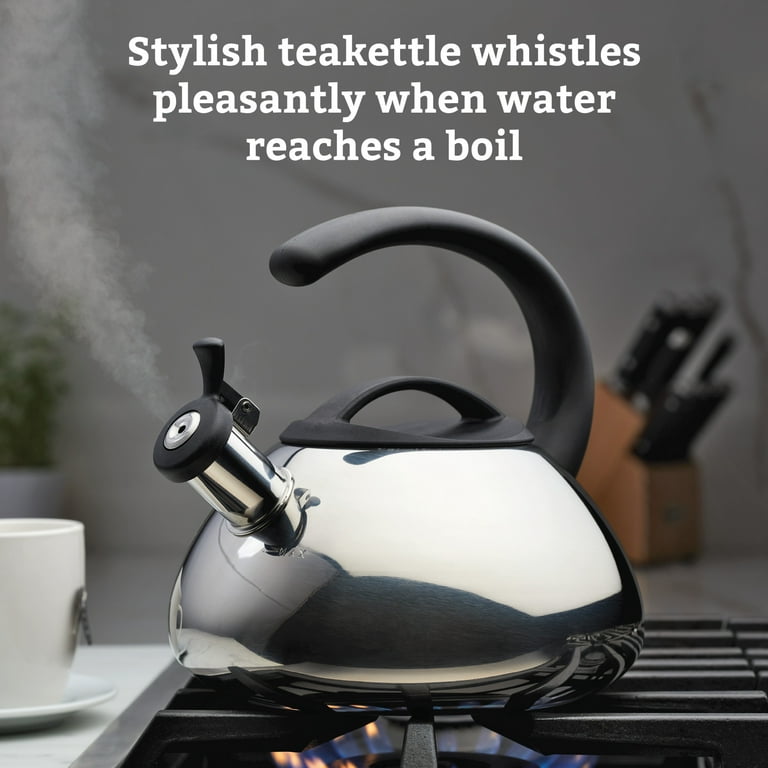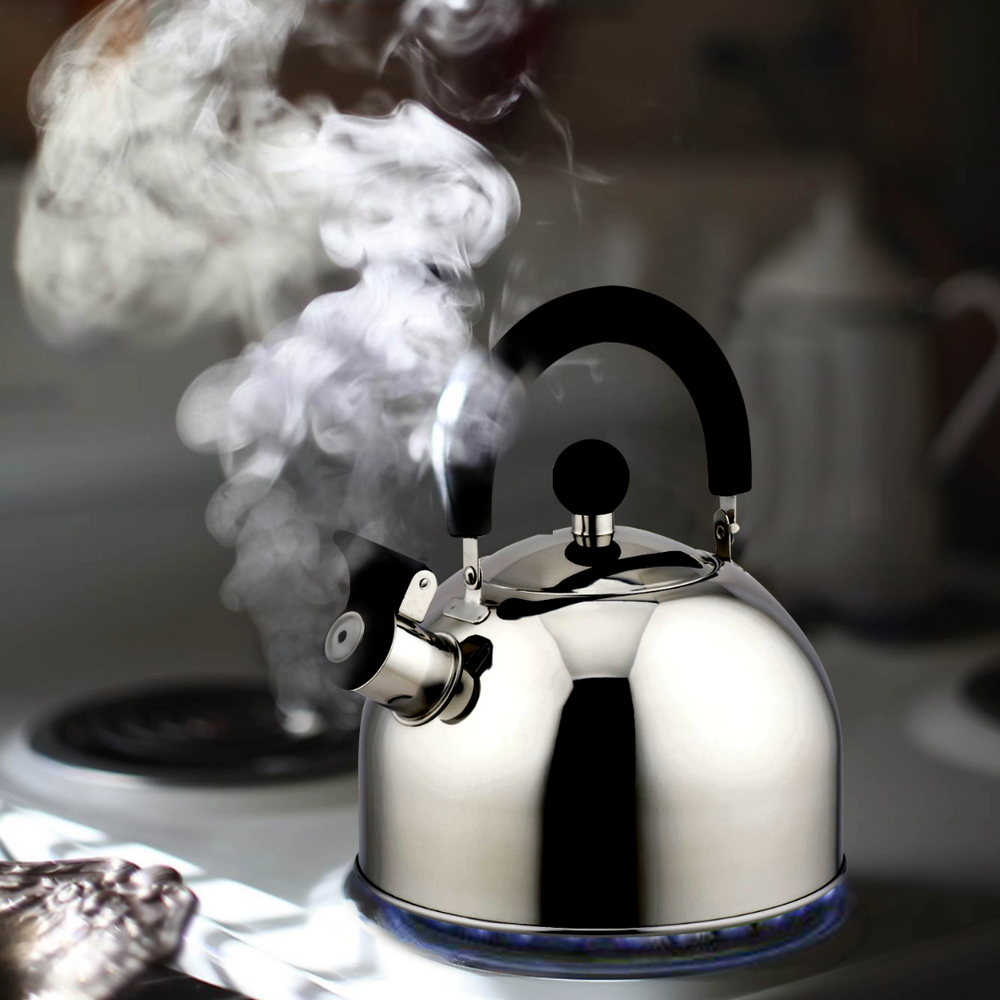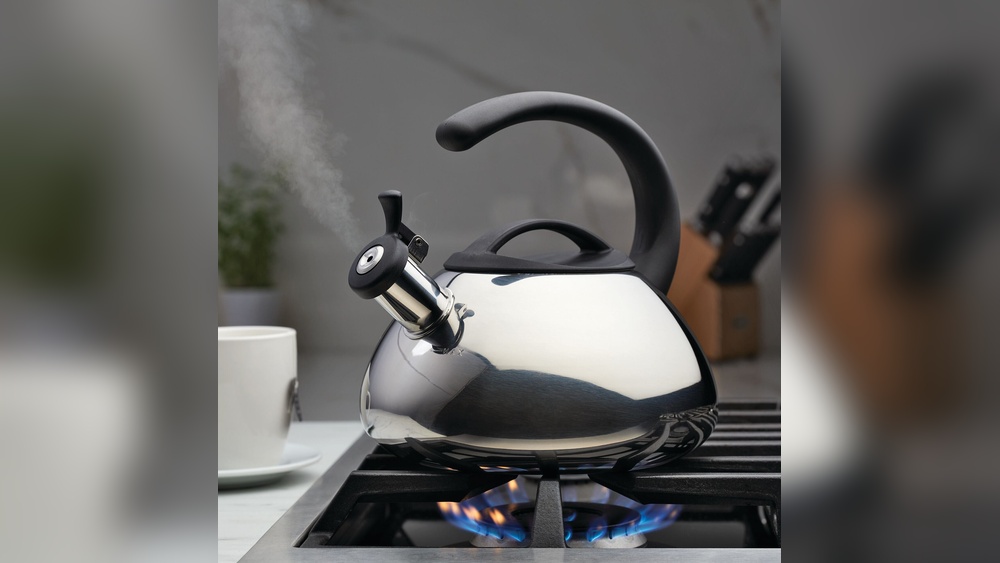Have you ever wondered why your tea kettle suddenly lets out that sharp, unmistakable whistle just as the water reaches a boil? That simple sound does more than grab your attention—it tells you your tea is ready without you having to watch the stove.
But what exactly causes this whistle? Understanding why tea kettles whistle can make your kitchen experience smarter and even a bit more fascinating. Keep reading, and you’ll discover the surprising science behind that familiar sound, why it matters for your daily routine, and how this clever design has stood the test of time.
Your next cup of tea will never sound the same again!

Credit: www.walmart.com
How Kettles Produce Sound
The sound of a whistling kettle is more than just noise. It is a result of steam moving through a small space. This movement creates vibrations that turn into sound waves. Understanding the process helps explain why the whistle changes pitch and volume as water boils.
The design of the kettle’s spout and whistle plays a big role. Each part works together to make the familiar whistling sound. Let’s break down how kettles produce this sound step by step.
Steam And Pressure Build-up
As water heats, it turns into steam. This steam fills the kettle and builds pressure inside. The pressure pushes the steam toward the spout. The faster the water boils, the more steam and pressure build up. This pressure is key to creating the whistle.
Narrow Spout Opening
The spout has a small opening called the whistle. This narrow space forces steam to speed up as it passes through. The fast-moving steam creates a high-pitched sound. The size of the opening controls the pitch and loudness of the whistle.
Vortex Formation Inside Whistle
When steam hits a second surface inside the whistle, it creates swirling air patterns. These swirls are called vortices. The vortices form and break quickly, making the air move in pulses. This pulsing is what produces the sharp whistle sound.
Air Vibration And Sound Waves
The pulsing air causes the surrounding air to vibrate. These vibrations travel as sound waves to your ears. The whistle’s tone changes with the speed and pressure of steam. Higher pressure makes the sound louder and sharper.

Credit: www.cam.ac.uk
Physics Behind The Whistle
The physics behind the whistle of a tea kettle is a fascinating blend of steam dynamics and sound production. As water boils, steam builds pressure inside the kettle. This steam escapes through a small opening designed to create a whistling sound. The process involves complex interactions between steam flow, pressure changes, and sound waves.
Steam Jet And High Velocity Flow
Boiling water produces steam that pushes through a narrow opening. This creates a high-speed jet of steam. The steam jet moves quickly because of the pressure inside the kettle. This fast flow is essential for producing the whistle sound.
Pressure Pulses And Vortices
The steam jet hits a small plate or surface inside the whistle. This impact causes the steam flow to become unstable. It forms swirling patterns called vortices. These vortices cause rapid pressure pulses in the air. These pressure changes are the key to making the whistle noise.
Sound Wave Generation
The vortices create vibrations in the air as they form and break apart. These vibrations travel as sound waves. The sound waves reach our ears as the familiar whistle of the kettle. The process is similar to how wind instruments produce sound.
Pitch And Tone Variation
The whistle’s pitch changes with steam pressure and temperature. Higher pressure makes the steam flow faster. This increases the frequency of vortices and sound waves. The tone becomes higher and louder as the water temperature rises. This change signals the water is ready.
Why Whistles Change While Heating
The whistle of a tea kettle does not stay the same while heating. It changes because several factors affect the sound. These changes happen as water heats, steam forms, and pressure builds inside the kettle. Understanding these reasons makes the whistling sound more interesting.
Each stage of heating changes the way steam moves through the whistle. This movement creates different sounds that you can hear. Let’s explore the main reasons why the whistle changes while the kettle heats up.
Temperature Effects
As the water heats, its temperature rises steadily. Higher temperature means steam forms faster and moves with more energy. This energy changes how the steam flows through the whistle. The faster steam causes the whistle to produce a higher pitch. Lower temperatures create a softer, lower whistle.
Pressure Fluctuations
Steam pressure inside the kettle changes as water boils. Pressure grows stronger as more steam builds up. When pressure pushes steam through the whistle, it makes the air inside vibrate. These vibrations create the whistling sound. Changes in pressure cause the whistle to shift in tone and loudness.
Steam Volume Impact
The amount of steam passing through the whistle affects its sound too. More steam means stronger vibrations and a louder whistle. Less steam produces a quieter, weaker sound. The volume of steam changes as water reaches full boil and steam escapes faster.

Credit: www.benecasa.com
History Of The Whistling Kettle
The history of the whistling kettle traces back to the early days of cooking and boiling water. People needed a simple way to know when water was ready without watching the pot constantly. The whistling kettle evolved as a practical tool, combining function with sound to signal boiling water. Its journey shows how design and technology worked together to improve everyday life.
Early Kettle Designs
Early kettles were basic metal pots heated over open fires. They lacked any form of sound or signal. People had to watch the kettle closely to avoid boiling over or drying out. These kettles were heavy and often made from cast iron or copper. Boiling water was a slow process and required constant attention.
Introduction Of The Whistle
The whistle feature appeared in the 19th century. Inventors added a small device on the spout to create noise from steam pressure. This whistle alerted users that the water had reached boiling point. The sound made it easier to multitask while heating water. This simple addition made kettles more user-friendly and safer to use.
Evolution Over Time
Over the years, kettles improved in materials and design. Whistles became louder and more reliable. Modern kettles use stainless steel and heat-resistant plastics. Some kettles now have adjustable whistles or no whistle at all. Electric kettles have changed the landscape but the classic whistling kettle remains popular. Its blend of tradition and function keeps it relevant in many kitchens today.
Advantages Of Whistling Kettles
Whistling kettles offer practical benefits beyond their charming sound. The whistle signals that water has reached boiling point. This feature helps users avoid overboiling and unnecessary waiting. Whistling kettles also support energy savings and add ease to daily routines.
Boiling Alert Feature
The whistle alerts you instantly when water boils. This stops you from watching the kettle closely. You can focus on other tasks without worry. It prevents water from boiling dry and damaging the kettle. The sound works as a clear, simple signal every time.
Energy Efficiency
Whistling kettles save energy by signaling when to turn off heat. This avoids wasting fuel or electricity. You do not need to keep the stove on longer than necessary. The whistle helps reduce overall energy use in the kitchen. It supports eco-friendly habits with no extra effort.
Convenience In Use
The kettle’s whistle makes boiling water convenient and easy. It allows hands-free operation, freeing you for other tasks. The sound is loud enough to hear from other rooms. This is helpful in busy kitchens or large homes. The design improves everyday comfort and efficiency.
Modern Innovations
Modern tea kettles combine traditional sounds with new technology. These innovations make boiling water easier and safer. They also improve the classic whistle that signals when water is ready. Let’s explore how modern designs shape the whistling experience.
Electric Vs. Stovetop Kettles
Electric kettles heat water faster than stovetop models. They use electric elements inside the kettle base. Many electric kettles do not have whistles. Instead, they turn off automatically once water boils. Stovetop kettles still use the classic whistle to alert users. Both types serve the same purpose but differ in noise and speed.
Quieter Whistle Designs
New kettle models use softer whistles to reduce noise. Designers create smaller or adjustable openings for steam. This change lowers the pitch and volume of the whistle. Some kettles offer a silent mode for peaceful kitchens. This is helpful for early mornings or quiet homes.
Material Improvements
Modern kettles use better materials for durability and sound. Stainless steel is popular for its strength and heat resistance. Some kettles have ceramic or glass bodies for style and clarity. These materials also affect how the whistle sounds. Improved seals and spouts help control steam flow for a clear whistle.
Frequently Asked Questions
What Is The Point Of A Whistling Kettle?
A whistling kettle signals when water reaches boiling by producing a loud whistle. This alert prevents overheating and saves energy.
What Causes A Tea Kettle To Whistle?
A tea kettle whistles when steam from boiling water passes through a small spout opening. This steam creates vibrations that produce sound waves, forming the whistle. The pressure and temperature of the steam affect the whistle’s pitch and volume.
What Is The History Of The Whistling Kettle?
The whistling kettle dates back to the 19th century. It signals boiling water by producing sound through steam pressure. Its design improved kitchen safety and convenience, becoming popular worldwide for easy tea and coffee preparation.
Are Whistling Kettles Better?
Whistling kettles alert you when water boils, preventing overboiling and saving energy. They improve safety and convenience during use.
Conclusion
A tea kettle whistles because steam passes through a small opening. This steam creates vibrations that produce the sound. The whistle helps you know when water boils. Different kettles may have different whistle tones. This simple sound saves time and prevents accidents.
Now, you understand why your kettle makes that noise. Next time you hear it, remember the steam’s journey inside. It’s science working quietly in your kitchen.

